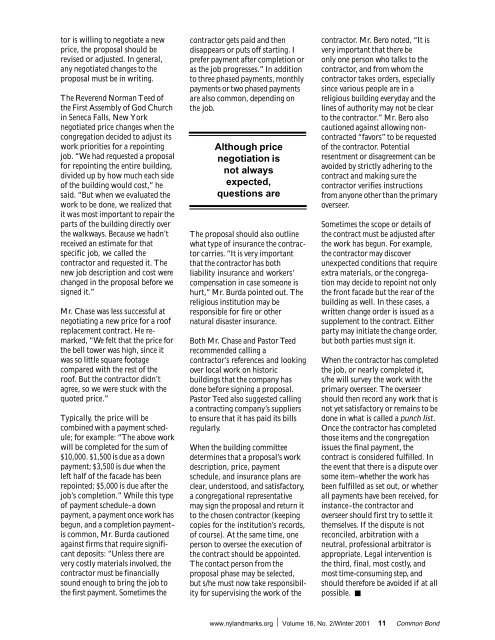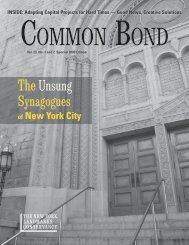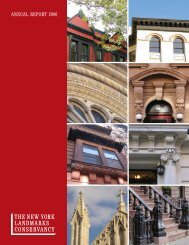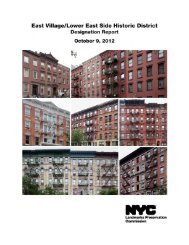Download Common Bond - The New York Landmarks Conservancy
Download Common Bond - The New York Landmarks Conservancy
Download Common Bond - The New York Landmarks Conservancy
You also want an ePaper? Increase the reach of your titles
YUMPU automatically turns print PDFs into web optimized ePapers that Google loves.
tor is willing to negotiate a new<br />
price, the proposal should be<br />
revised or adjusted. In general,<br />
any negotiated changes to the<br />
proposal must be in writing.<br />
<strong>The</strong> Reverend Norman Teed of<br />
the First Assembly of God Church<br />
in Seneca Falls, <strong>New</strong> <strong>York</strong><br />
negotiated price changes when the<br />
congregation decided to adjust its<br />
work priorities for a repointing<br />
job. “We had requested a proposal<br />
for repointing the entire building,<br />
divided up by how much each side<br />
of the building would cost,” he<br />
said. “But when we evaluated the<br />
work to be done, we realized that<br />
it was most important to repair the<br />
parts of the building directly over<br />
the walkways. Because we hadn’t<br />
received an estimate for that<br />
specific job, we called the<br />
contractor and requested it. <strong>The</strong><br />
new job description and cost were<br />
changed in the proposal before we<br />
signed it.”<br />
Mr. Chase was less successful at<br />
negotiating a new price for a roof<br />
replacement contract. He remarked,<br />
“We felt that the price for<br />
the bell tower was high, since it<br />
was so little square footage<br />
compared with the rest of the<br />
roof. But the contractor didn’t<br />
agree, so we were stuck with the<br />
quoted price.”<br />
Typically, the price will be<br />
combined with a payment schedule;<br />
for example: “<strong>The</strong> above work<br />
will be completed for the sum of<br />
$10,000. $1,500 is due as a down<br />
payment; $3,500 is due when the<br />
left half of the facade has been<br />
repointed; $5,000 is due after the<br />
job’s completion.” While this type<br />
of payment schedule–a down<br />
payment, a payment once work has<br />
begun, and a completion payment–<br />
is common, Mr. Burda cautioned<br />
against firms that require significant<br />
deposits: “Unless there are<br />
very costly materials involved, the<br />
contractor must be financially<br />
sound enough to bring the job to<br />
the first payment. Sometimes the<br />
contractor gets paid and then<br />
disappears or puts off starting. I<br />
prefer payment after completion or<br />
as the job progresses.” In addition<br />
to three phased payments, monthly<br />
payments or two phased payments<br />
are also common, depending on<br />
the job.<br />
Although price<br />
negotiation is<br />
not always<br />
expected,<br />
questions are<br />
<strong>The</strong> proposal should also outline<br />
what type of insurance the contractor<br />
carries. “It is very important<br />
that the contractor has both<br />
liability insurance and workers’<br />
compensation in case someone is<br />
hurt,” Mr. Burda pointed out. <strong>The</strong><br />
religious institution may be<br />
responsible for fire or other<br />
natural disaster insurance.<br />
Both Mr. Chase and Pastor Teed<br />
recommended calling a<br />
contractor’s references and looking<br />
over local work on historic<br />
buildings that the company has<br />
done before signing a proposal.<br />
Pastor Teed also suggested calling<br />
a contracting company’s suppliers<br />
to ensure that it has paid its bills<br />
regularly.<br />
When the building committee<br />
determines that a proposal’s work<br />
description, price, payment<br />
schedule, and insurance plans are<br />
clear, understood, and satisfactory,<br />
a congregational representative<br />
may sign the proposal and return it<br />
to the chosen contractor (keeping<br />
copies for the institution’s records,<br />
of course). At the same time, one<br />
person to oversee the execution of<br />
the contract should be appointed.<br />
<strong>The</strong> contact person from the<br />
proposal phase may be selected,<br />
but s/he must now take responsibility<br />
for supervising the work of the<br />
contractor. Mr. Bero noted, “It is<br />
very important that there be<br />
only one person who talks to the<br />
contractor, and from whom the<br />
contractor takes orders, especially<br />
since various people are in a<br />
religious building everyday and the<br />
lines of authority may not be clear<br />
to the contractor.” Mr. Bero also<br />
cautioned against allowing noncontracted<br />
“favors” to be requested<br />
of the contractor. Potential<br />
resentment or disagreement can be<br />
avoided by strictly adhering to the<br />
contract and making sure the<br />
contractor verifies instructions<br />
from anyone other than the primary<br />
overseer.<br />
Sometimes the scope or details of<br />
the contract must be adjusted after<br />
the work has begun. For example,<br />
the contractor may discover<br />
unexpected conditions that require<br />
extra materials, or the congregation<br />
may decide to repoint not only<br />
the front facade but the rear of the<br />
building as well. In these cases, a<br />
written change order is issued as a<br />
supplement to the contract. Either<br />
party may initiate the change order,<br />
but both parties must sign it.<br />
When the contractor has completed<br />
the job, or nearly completed it,<br />
s/he will survey the work with the<br />
primary overseer. <strong>The</strong> overseer<br />
should then record any work that is<br />
not yet satisfactory or remains to be<br />
done in what is called a punch list.<br />
Once the contractor has completed<br />
those items and the congregation<br />
issues the final payment, the<br />
contract is considered fulfilled. In<br />
the event that there is a dispute over<br />
some item–whether the work has<br />
been fulfilled as set out, or whether<br />
all payments have been received, for<br />
instance–the contractor and<br />
overseer should first try to settle it<br />
themselves. If the dispute is not<br />
reconciled, arbitration with a<br />
neutral, professional arbitrator is<br />
appropriate. Legal intervention is<br />
the third, final, most costly, and<br />
most time-consuming step, and<br />
should therefore be avoided if at all<br />
possible. n<br />
www.nylandmarks.org ⏐ Volume 16, No. 2/Winter 2001 11 <strong>Common</strong> <strong>Bond</strong>
















